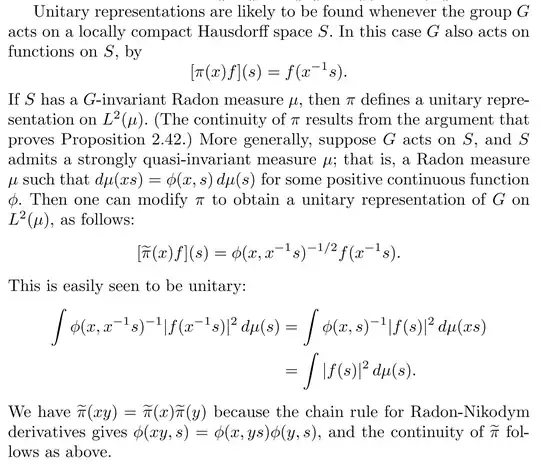You seem to be right.
Note that you are also making a choice on the "direction" of the action on functions. If $\alpha_\bullet: G\curvearrowright S$ (i.e. $\alpha_\bullet: G\to \operatorname{Homeo}(S)$ in our setting) is a (left) group action, then $\alpha_\bullet^{-1}: S\curvearrowleft G$ (i.e. $\alpha_\bullet^{-1}: G^{\operatorname{op}}\to \operatorname{Homeo}(S)$ (or $\alpha_\bullet^{-1}: G\to \operatorname{Homeo}(S)^{\operatorname{op}}$), where the opposite group is defined as in Prove that $G^{op} \cong G$ when $G^{op}$ is the opposite group of G) is a right group action (and vice versa). Then on functions $F(S)$ on $S$ one has a right action $\overleftarrow{\alpha_\bullet}:F(S)\curvearrowleft G$ by $g\mapsto [ f\mapsto [s\mapsto f\circ \alpha_g(s)]]$ and a left action $\overleftarrow{\alpha_\bullet^{-1}}:G \curvearrowright F(S)$ by $g\mapsto [ f\mapsto [s\mapsto f\circ \alpha_g^{-1}(s)]]$. Note that the leftward arrow denotes that the action is via pullbacks and $-1$ signifies if the inverse of an element is used to do the pullback (this distinction becomes important when one considers $f:S\to S$).
Now if the set $F(S)$ of functions on $S$ has $\mathbb{C}$ specified as the codomain, one can consider actions $\pi_\bullet: F(S;\mathbb{C})\curvearrowleft G$, $g\mapsto [f\mapsto [s\mapsto f\circ\alpha_g(s)\,\chi(s,g)]]$ for some function $\chi: S\times G\to \mathbb{C}^\times= \mathbb{C}\setminus 0$ (which, if $\pi_\bullet$ is to be a group action, will be required to satisfy an algebraic equation similar to that of the chain-rule for the Radon-Nikodym derivative (see https://math.stackexchange.com/a/4348317/169085 )). If in addition a Radon measure $\mu$ on $S$ is fixed, for $p\in [1,\infty]$ one can consider $\pi_\bullet$ to be acting on $L^p(S,\mu;\mathbb{C})$ and engineer a $\chi$ so that the action is by isometries (or some other class of operators). In this context solving the equation (for $p<\infty$ for simplicity)
$$\forall g\in G,\forall f\in L^p(S,\mu;\mathbb{C}): |\pi_g(f)|^p_{L^p(S,\mu;\mathbb{C})}=|f|^p_{L^p(S,\mu;\mathbb{C})}$$
determines (the modulus of) $\chi$ as the $p$-th root of the reciprocal of the Radon-Nikodym cocycle.
The same framework can be extended without much hassle to the case of two (locally compact Hausdorff second countable (= LCHSC)) groups $G,H$ acting on two LCHSC spaces $S,T$, via $\alpha_\bullet$ and $\beta_\bullet$, respectively. The aim is to take the $\alpha_\bullet$ action $G\curvearrowright S$ and turn it onto a $G$ action $G\curvearrowright F(S;T)$ on some space of functions from $S$ to $T$, and using the $\beta_\bullet$ action to "twist"($\ast$) the functions along the $G$ action. The objects that allow one to do this are called $H$-valued $1$-cocycles over the action $\alpha_\bullet$ (typically simply cocycles), and they satisfy an algebraic equation similar to that satisfied by the Radon-Nikodym derivative or the scalar function $
\chi$ above (see the second discussion I've linked above for some intuition why one would want to do this). There are again multiple choices of handedness involved.
Going even more general, one can consider the ("separable") extensions $\widehat{\alpha}_\bullet: G\curvearrowright \widehat{S}$ of $\alpha_\bullet:G\curvearrowright S$. The previous paragraph corresponds to the case of $\widehat{S}=S\times T$; in this case the sections of $\widehat{S}\to S$ are completely determined by functions from $S$ to $T$.
For more on all this see e.g. Zimmer's book Ergodic Theory and Semisimple Groups, p.65.
($\ast$: There is also something called a "twisted cocycle"; this is also a cocycle as I've defined above but with a different kind of twist. The above cocycles are called untwisted, if a comparison with twisted cocycles are needed.)
